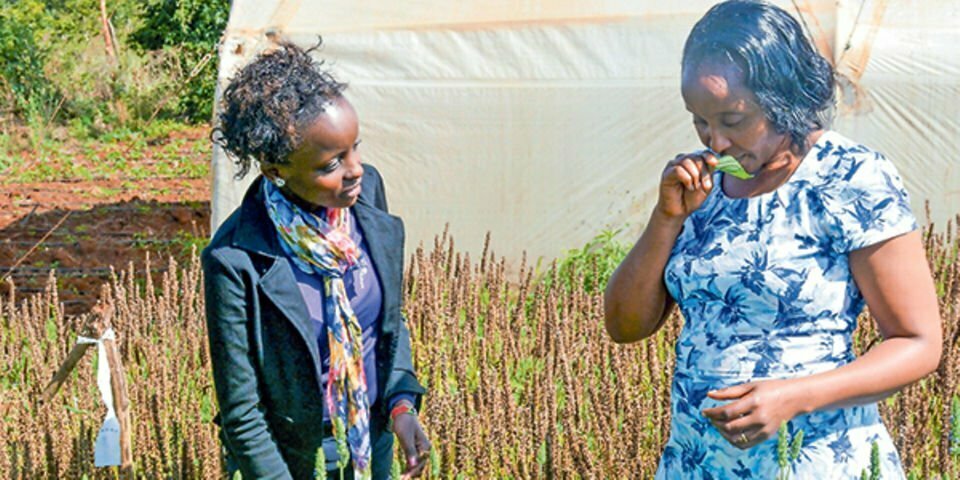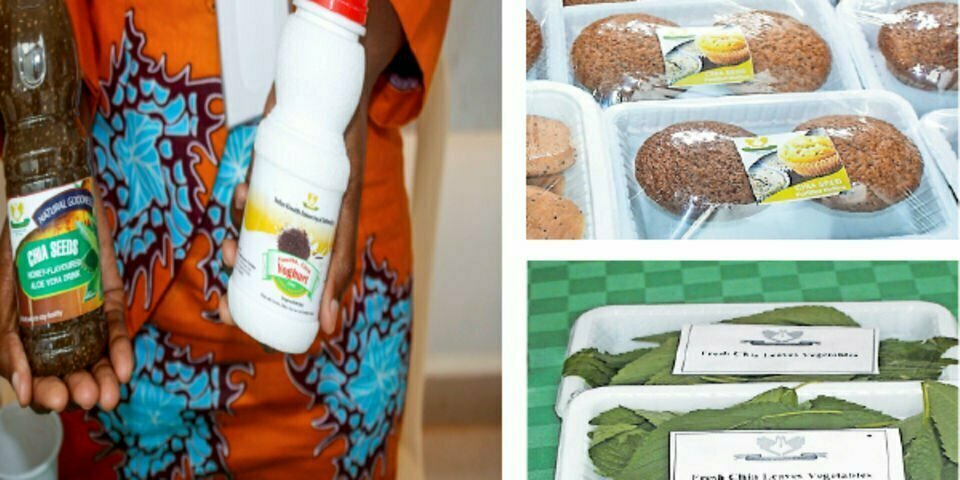Its luxuriant blue flowers and green leaves always stand out on the farm, especially if the crop is grown large-scale.
But the herb does not only shine on the farm. On the dining table, chia (Salvia hispanica) is a superfood, whose seeds have become popular due to their immense benefits.
Its brown, nutrient-rich seeds are good sources of omega-3 fatty acid, protein, fibre, vitamins, minerals and antioxidants.
And as demand for chia seeds grows with the high rates of lifestyle diseases, food scientists are exploring ways to popularise the consumption of the crop, especially through value addition.
Dr Monicah Mburu, a food scientist at the Institute of Food Bio-resources Technology at the Dedan Kimathi University of Technology (Dekut) in Nyeri, says chia is a climate-smart crop that can put money in farmers’ pockets amid the increasingly erratic weather.
Manufacturers, she adds, can use it to make an array of products for more cash.
Dr Mburu, who is researching on the crop, discussed with the Seeds of Gold the various products one can make from chia.
Chia yoghurt
Most people are used to strawberry, passion or vanilla yoghurt, but how about adding chia to the three flavours for a more composite product? Dr Mburu says chia yoghurt is rich in taste and nutrients.
To make the product, one first prepares chia seeds by putting them in warm water to remove the outer cover. Then you add them to milk before pasteurising it to between 80-90 degrees Celsius.
“Chia in yoghurt is added at the formulation stage as it is used as a stabiliser and thickener,” says Mburu.
Then let the milk cool to 450 Celsius and add bacterial culture and later the preferred flavour.
Fortified chia cookies, muffins, bread and chapatis
You can enrich the nutritional value of wheat products such as cookies, muffins, chapatis, bread and cakes using chia.
Since chia is absorbent, it should be added in the dough of the product one intends to make, says Dr Mburu.
The seeds can also be used as a substitute for eggs while baking. One adds a tablespoon of chia with three tablespoons of water.
“When you are making the dough and just about to add butter to the mixture, add chia seeds, which will help in providing nutrients such as fibre and protein in the baked foods.”
Chia seeds can also be sprinkled on top of baked foods such as bread, oatmeal and muffins.
Composite flour
These are flours from cereal crops such as millet and sorghum or tubers such as cassava and yam, which are rich in starch.
They can be mixed with defatted chia cake obtained from chia oil. The cake can also be used as a soup thickener or stabiliser.
“Composite flour is an immune booster and is highly nutritious. It is recommended for infant complementary feeding,” says Dr Mburu.

The chia cake can also be used as a binder for cow cake – a supplementary animal feed made from chia biomass. It is good for cows since chia is rich in proteins and fats.
Chia leaves products
Chia comes from the same family as mint. It is, therefore, a herb that serves as an antioxidant, which improves overall health as well as boosts energy.
Chia leaves can be used while dried as powder or freshly picked from the farm as a vegetable, just like spinach or sukuma wiki (collard greens), to complete a meal of ugali.
“The leaves contain essential oils, which can be used as condiment or a flavour enhancer,” says Dr Mburu.
The dried leaves, when milled, make good powder that can be used to make tea or sprinkled on foods such as rice or cereals to enhance nutritional value.
“Tea made from chia leaves is therapeutic and aids in purifying the body. The powder is rich in phytochemicals,” she says.
To make green tea, one can use dried leaves from a mature chia plant, notes Dr Mburu, who adds that chia plant is suitable for organic farming since it has strong repellent characteristics to a wide range of insects.
Chia (omega-3) capsules
Food scientists note that chia seeds are composed of 35 per cent oil, which has omega-3 and omega-6 nutrients. Most people prefer capsules compared to taking the raw seeds since they are convenient to carry around.
“They are very important in helping people regain their memory as well as boosting brain capacity,” Dr Mburu notes, adding that one should take a capsule a day.
This product, according to her, is highly recommended for people living with lifestyle diseases since chia helps regulate blood pressure and diabetes as well as in weight loss.
Chia Kombucha drink
This is a fermented and slightly alcoholic drink that is consumed to boost the immune system, detoxify the liver and is beneficial to the digestive system. Once combined with chia seeds, Dr Mburu says, it results in a “power-packed, energy and health-boosting drink.”
Chia lotion and hair food
The products are made from chia oil extracts, which are rich in omega-3, which is helpful to hair, scalp and the skin.
The products can be used as moisturiser and reliever for irritated scalps or skins.
As hair food, it has an ability to restore damaged hair and help brittle hair regain its elasticity.
The oils are rich in protein, phosphorus and zinc, which help in maintaining strong hair structure, making it less prone to shedding and breakage, notes Dr Mburu.
She adds that the oil element in chia aids in healing of blemished or inflamed skin.
****
All you need to know about growing it
The ecological requirements
Catherine Wanjiru, a researcher based at the Kenya Agricultural and Livestock Research Organisation (Karlo) in Embu says chia does well in areas with altitudes ranging from 400 to 2,500 metres above sea level. The areas should receive average rainfall of 500 to 1,000mm.
“The crop is climate-smart and produces in plenty during the rainy season,” she says.
Where can I grow it in Kenya?
It grows in many areas across the country, which have both high and low altitudes. Wanjiru says the crop requires adequate rainfall or water for the first two months. Those in low rainfall areas are advised to use irrigation.
How is it propagated?
Chia can be propagated in two ways; first it can be planted in the nursery and then transferred to the field or it can be planted in the field directly.

To plant chia in the bed, select a site that receives full sunlight for about six to eight hours a day since it flourishes under full sunlight.
The soil should be loose and well-drained and manured. Prepare the beds by digging eight inches of the top soil and then plant. The bed should be watered daily and the plants should sprout after about a week.
The young plants should be watered daily until they are fully established since mature plants are tolerant to dry periods and need occasional water when the rainfall is low.
In the field, sowing of chia seeds is done in shallow furrows. Do not bury them in the soil. Just cover them with a thin layer of soil to protect them from birds or predators, says Wanjiru.
The plants should be 12 inches apart and weeding should be done frequently to ensure they are not suppressed by wild plants.
Chia is sensitive to herbicides and weeding can be a major problem in the initial stages of the crop, thus mechanical weed control is recommended.
Pick out the weeds, do not dig up or turn all the top soil since this will expose the crop. Apply mulch and compost regularly to improve the growth of plants and control weeds.
How are chia seeds harvested and prepared?
Chia seeds are harvested after four months. A farmer can tell when the plant is mature when all the petals fall off.
“It is advisable to harvest the chia tussles when they are still green and dry them rather than waiting for them to dry in the field to prevent wastage of seeds when they fall,” notes Peter Mwirigi, an agronomy scientist.
Once the chia seeds are harvested, they are thrashed and sorted for various uses. While making flour, one has to de-fat the seeds, which involves extraction of oils before grinding them.
Where does one get the seeds?
Currently, people are buying from other farmers, but Kalro and Kephis are working with other stakeholders to propagate clean seeds that are also high-yielding.
Credit: Source link